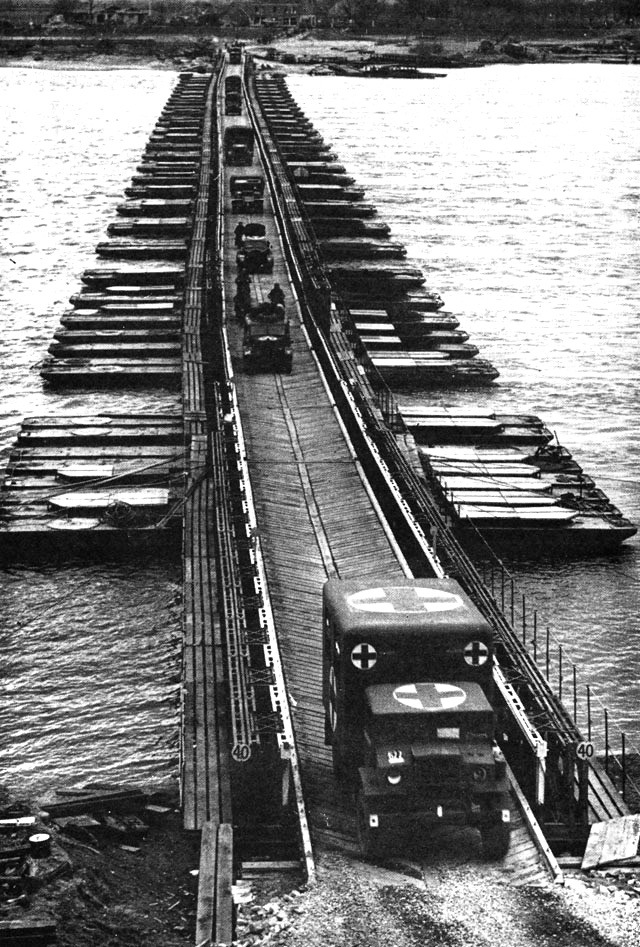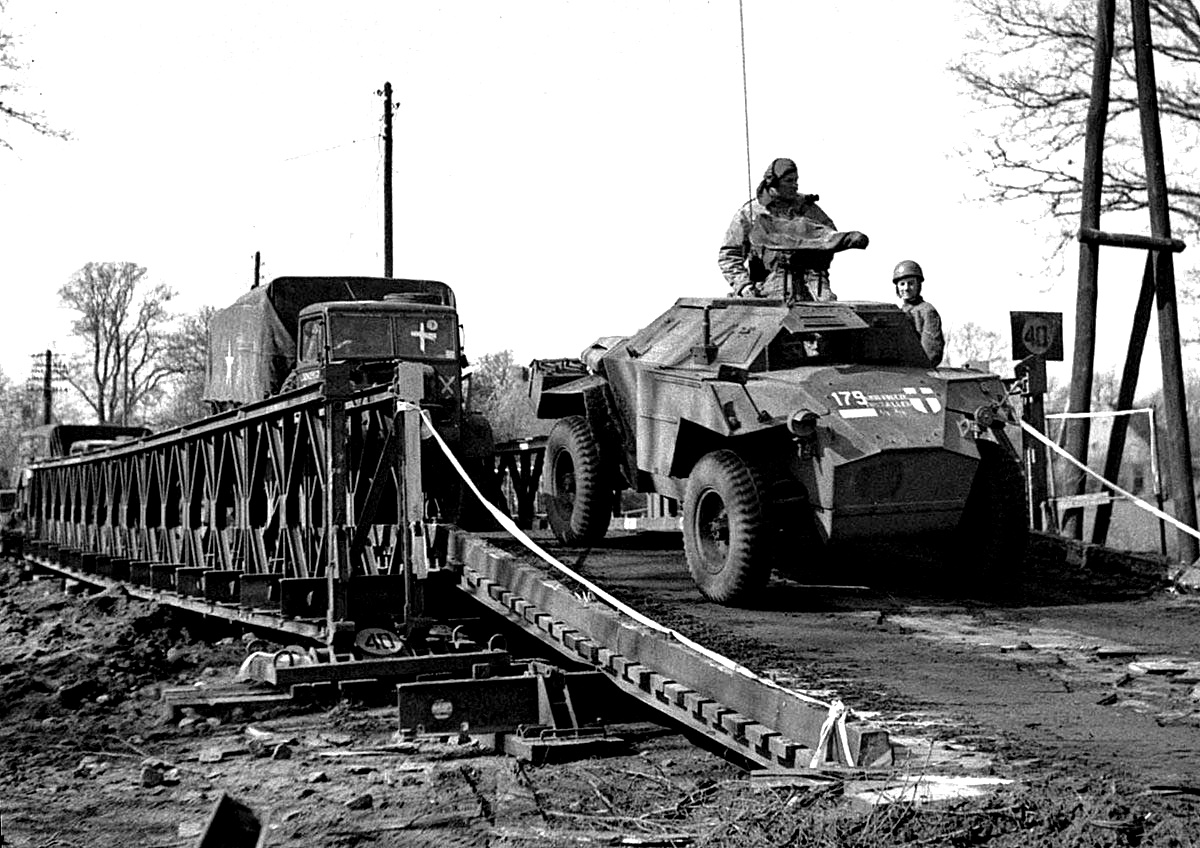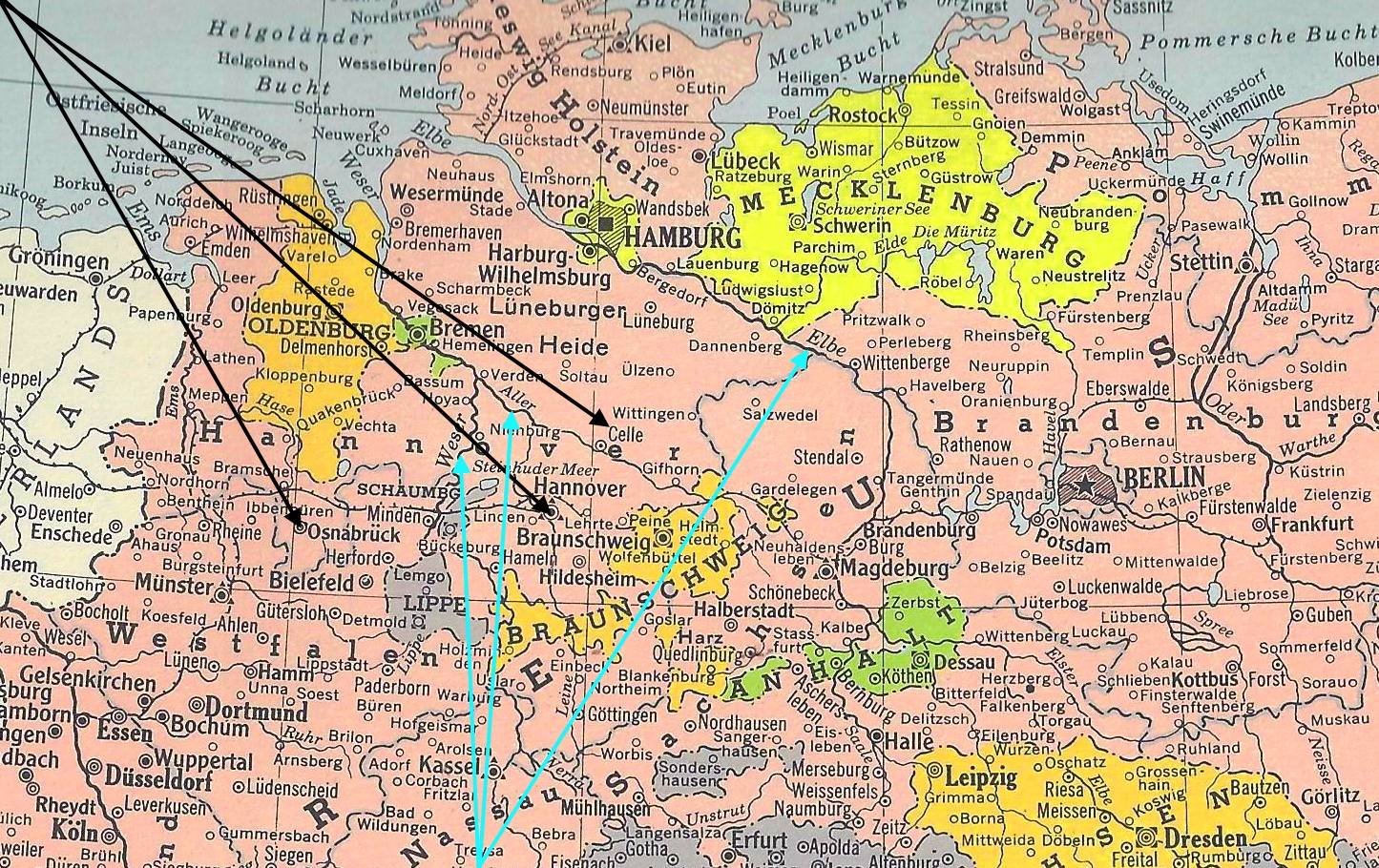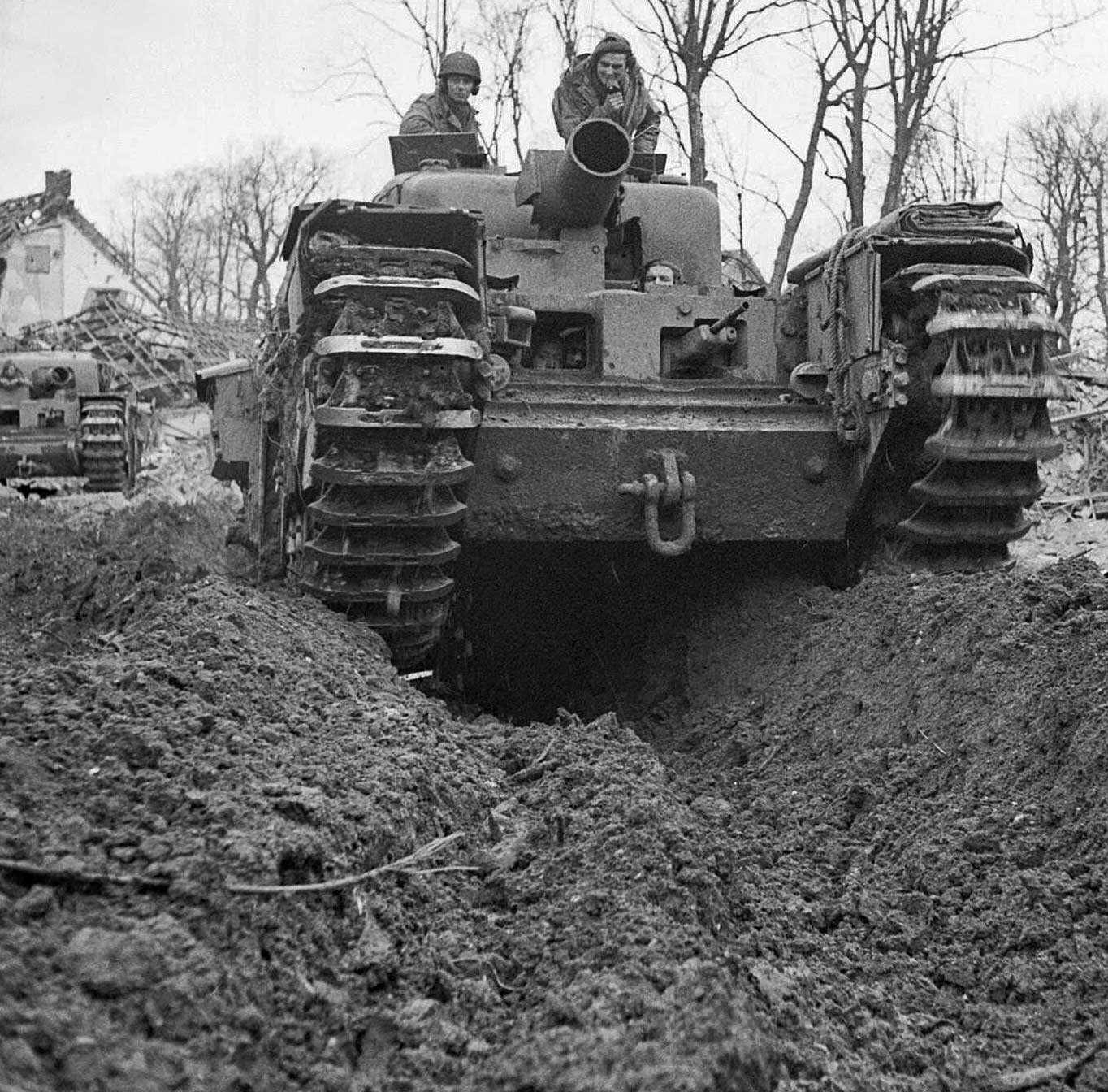(47) Resuming its advance at 0800, March 28, the 1-CPB passed north of the Wesel Forest and of the village of Erle, thence along a main road leading eastward. No enemy resistance was encountered until just beyond Rhade, where air bursts were fired overhead from enemy AAA guns located in the woods ahead. That evening, Able and Charlie Cos successfully attacked and destroyed these AAA guns and the Battalion was able to proceed to the village of Lembeck. There the companies took up defensive positions on the outskirts of the town but, were not troubled again.
(48) For two nights and a day the Canadians rested while the enemy showed no signs of activity. The weather on March 29, was cloudy with considerable rain but personnel was made happy with an issue of cigarettes and chocolate from the auxiliary services officer. This short rest in Lembeck was very welcome after the week’s fighting and before the long chase across Germany swung into full speed. With both stages of Operation Varsity successfully completed, the door into Germany had been battered down and the Allies had crossed the threshold.
Advance to the Elbe River
(49) Through every Rhine bridgehead Allied forces had poured into Germany to complete the encirclement of the Ruhr. By April 1, this had been achieved and the US Armies immediately began operations to eliminate the enemy forces trapped within. Once the Ruhr was no longer a threat, the Supreme Commander saw three main avenues by which the Allies could thrust deeper into Germany. In the north, a route lay across the North German plain toward the Baltic and Berlin. In central Germany, 3 routes were open to us through the gap in the enemy’s line created by the trapping of Army Group B in the Ruhr. In the south, an axis of advance was available through Nurnberg and Regensburg, by the Danube Valley into Austria, where the Russians were already threatening Vienna. Weighing the relative advantages that would accrue from an advance in strength in either north, center, or south, Eisenhower decided that an offensive first in the center would prove the most effective.
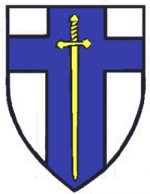
 (50) This decision necessitated a modification of the plans of FM Montgomery who on March 28, had directed the UK 2-A and the US 9-A to drive hard for the line of the River Elbe so as to gain quick possession of the plains of northern Germany. This is the time to take risks and to go ‘flat out’ for the Elbe. If we reach the Elbe quickly, we win the war. To take part in this drive the UK 8th Corps had been brought up from reserve and placed on tho right of the UK 2-A. The Supreme Commander’s decision, however, called for the US 9-A including the US 17-A/B to be removed from the UK 21-AG on April 4, in order to form the left wing of the American offensive, thus reducing the striking power in the north. The aim of the UK 21-AG remained to reach the line of the Elbe in our sector. Now that the Allies would not be so relatively strong in the northern sector, it was to be anticipated that these tasks would take longer than previously hoped, and the UK 2-A would require to watch for the security of its southern flank.
(50) This decision necessitated a modification of the plans of FM Montgomery who on March 28, had directed the UK 2-A and the US 9-A to drive hard for the line of the River Elbe so as to gain quick possession of the plains of northern Germany. This is the time to take risks and to go ‘flat out’ for the Elbe. If we reach the Elbe quickly, we win the war. To take part in this drive the UK 8th Corps had been brought up from reserve and placed on tho right of the UK 2-A. The Supreme Commander’s decision, however, called for the US 9-A including the US 17-A/B to be removed from the UK 21-AG on April 4, in order to form the left wing of the American offensive, thus reducing the striking power in the north. The aim of the UK 21-AG remained to reach the line of the Elbe in our sector. Now that the Allies would not be so relatively strong in the northern sector, it was to be anticipated that these tasks would take longer than previously hoped, and the UK 2-A would require to watch for the security of its southern flank.
It was decided to establish an intermediate phase in the advance to the Elbe River, on the line of the Weser River, the Aller River and the Leine River. It had also been intended, prior to the change in the overall Allied plan, to employ the US XVIII Corps (Airborne) on the right of UK VIII Corps, to capture Munster. This Corps, however, ceased to be operational on March 30, and it was left to the XIII Corps, under the US 9-A, to reduce Munster on April 3. The British elements assigned in the US XVIII Corps (Airborne), the UK 6-A/B had passed to the UK VIII Corps on March 29. Other formations under command of the VIII Corps were the UK 15th Infantry Division and the UK 11th Armoured Division.
(51) The new plan was issued to Montgomery’s 21-AG on April 5. The UK 2-A now had the XXX Corps on the left, XII Corps in the center, and the VIII Corps on the right, where enemy resistance proved to be lightest although the Germans did a thorough job of demolishing bridges over a network of waterways. The VIII Corps nevertheless was able to cross the Dortmund-Ems Canal without undue difficulty and to clear Osnabruck. On April 5, the UK 6-A/B captured Minden on the Weser River and seized a bridgehead over the river. On April 7, the VIII Corps advanced north from the Weser and by April 10, had established bridgeheads over the Aller River. Thereafter hard fighting took place around Uelzen, southeast of Hamburg before advance elements reached the Elbe River on April 19, and several days were required to mop up the enemy. Eventually, by April 24, the west bank of the river had been cleared throughout the Corps sector. About the same time, the XII Corps closed to the Elbe just south of Hamburg and later the XXX Corps, having paused to take Bremen, crossed the Weser to reach the Elbe estuary below Hamburg.
(52) Advancing over 200 miles with relatively light strength for so wide a sector, the UK 2-A Amy had thus lined itself up on the Elbe in very good time. The War Diary of the 1-CPB relates many interesting experiences and incidents which occurred during this swift dash into northern Germany. Earlier aspects in which the Canadian paratroopers for the first time rode into battle on tanks of the British 6th Guards Tank Brigade.
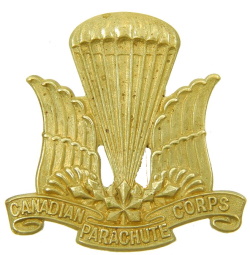 (53) On March 30, the 1-CPB embussed in RASC lorries at Lembeck and at 0915, moved off northward to Coesfeld, which RAF bombers had completely wrecked. There the Canadians met #1 and #3 Squadrons of the 4th Battalion Grenadier Guards, 6th Guards Tank Brigade, who had been delayed an hour in getting through the rubble in the town, and by 1000, was preparing to make a lightning dash to capture a vital bridge over the Ems River at Graven, 35 miles distant. The Paratroopers of Able and Baker Cos were ordered to leave the transport buses and climb on the tanks of these two squadrons, a Company to each squadron. In both cases, the leading troop carried no infantry so that their guns could be fired immediately if any opposition was encountered. At first, a series of delays were encountered as both squadrons attempted to race along winding roads. #3 on the left had to clear booby-traps trees felled where the road crossed a small range of hills. Then, on receiving a warning from a Frenchman who had appointed himself as a guide, lightly-armored Honey tanks had to be sent ahead to shoot up a Hitler Jugend Barracks. The crew of the leading one was practically wiped out, whereupon the paratroopers immediately jumped off the tanks and aided by the unorthodox but extremely effective manœuvres of the Frenchman, disposed of the Hitler Jugend.
(53) On March 30, the 1-CPB embussed in RASC lorries at Lembeck and at 0915, moved off northward to Coesfeld, which RAF bombers had completely wrecked. There the Canadians met #1 and #3 Squadrons of the 4th Battalion Grenadier Guards, 6th Guards Tank Brigade, who had been delayed an hour in getting through the rubble in the town, and by 1000, was preparing to make a lightning dash to capture a vital bridge over the Ems River at Graven, 35 miles distant. The Paratroopers of Able and Baker Cos were ordered to leave the transport buses and climb on the tanks of these two squadrons, a Company to each squadron. In both cases, the leading troop carried no infantry so that their guns could be fired immediately if any opposition was encountered. At first, a series of delays were encountered as both squadrons attempted to race along winding roads. #3 on the left had to clear booby-traps trees felled where the road crossed a small range of hills. Then, on receiving a warning from a Frenchman who had appointed himself as a guide, lightly-armored Honey tanks had to be sent ahead to shoot up a Hitler Jugend Barracks. The crew of the leading one was practically wiped out, whereupon the paratroopers immediately jumped off the tanks and aided by the unorthodox but extremely effective manœuvres of the Frenchman, disposed of the Hitler Jugend.
Following the main road, meanwhile, #1 Squadron was fired on with Panzerfausts in Billerbeck. The Canadian Paratroopers acted as terriers and the tanks as guns, the Panzerfaustmen stood no chance. It was now a race against nightfall. Both squadrons pushed on at top speed, but #3 ran into another roadblock at Darfelt which, with the aid of the local priest, they were able to pass but too late to proceed further that night. #1 Squadron consequently raced on alone and found Altenburg full of surrender signs and like a deserted town. The deafening roar of the Churchill engines reverberated through the narrow streets and the only sign of life came from the groups of paratroopers huddled together on the back of the tanks. As they emerged on the eastern side of the town the light was fading, but they could just pick out the chimneys of Graven five miles away in the valley below. There was a steep tarmac road leading down into the valley, and the tanks rushed hell for leather down it. As the leader in the troop was reaching the bottom, someone suddenly noticed a long column of enemy lorries fleeing for all they were worth along a road leading away to the north. In a flash, the turrets of the whole Squadron revolved around to the left and fire streamed into the retreating Germans. But there was no time to stop. The tanks sped on through one village, then another, dealing on the way with an enemy staff car, fleeing bicyclists, and many other targets that the gunners could not resist.
They never slowed down until they had reached the suburbs of Graven, 500 yards from the bridge, where the paratroopers jumped off to rush forward and take it. In less than ten minutes it was in their hands – or so they thought – because only one bridge was marked on the map. But there were in actual fact two, and the one they had taken led to an island in the middle of the Ems. Twenty minutes later, there was a blinding flash followed by a loud explosion, and the real bridge, 300 yards upstream, crashed into the water. They had been true, if slightly prematurely, April-fooled but, to a small extent, the column got their own back on the Germans that night. For just after the bridge was blown, a passenger train came steaming into Graven carrying German soldiers on leave from the Russian front. The Canadians allowed them to kiss their wives and then promptly marched them off to spend their leave in a prisoner-of-war cage. No one got much sleep that night because at about 3 o’clock in the morning, the Germans blew up a huge ammunition dump on the other side of the river, and the fires and explosions did not die down for many hours. This map error was most unfortunate as the second bridge could have been taken with little trouble, but in capturing the town, Able Co did great execution. Canadian losses during the day included Capt McGowan killed in action and five other ranks wounded at night, however, heavy enemy shelling brought further casualties.

 (54) Rain returned the next day and the morning was spent impatiently waiting for a Bailey Bridge to be built across the Ems River. During the afternoon the 1-CPB, together again, crossed on foot and passed through the 8th and the 9th Parachute Bns to halt on the west bank of the Dortmund-Ems Canal. Once more, heavy enemy shelling during the night caused several casualties.
(54) Rain returned the next day and the morning was spent impatiently waiting for a Bailey Bridge to be built across the Ems River. During the afternoon the 1-CPB, together again, crossed on foot and passed through the 8th and the 9th Parachute Bns to halt on the west bank of the Dortmund-Ems Canal. Once more, heavy enemy shelling during the night caused several casualties.
(55) In teeming rain the next morning the Battalion crossed the canal on a blown bridge passable only on foot, and with Charlie Co-leading proceeded to attack Ladborgen (Greven). The village was defended by one 40-MM and two 20-MM AAA guns supported by a platoon of infantry, most of whom were killed. Several Bn Hq officers who had carried hay boxes of compo food across the canal later arrived at Ladborgen in an exhausted condition, only to find the troops eating fried chicken, eggs, vegetables, and various preserved fruits. The Battalion rested there over 36 hours while the enemy Hq at Iburg less than 12 miles east remained blissfully unaware the invaders were even across the Dortmund-Ems Canal, for a German dispatch rider captured April 2, bore a message to the local commander at Ladborgen informing him not to expect further reinforcements.
(56) Taking to the road again on April 3, and preceded by the 8 and the 9-PB, the Canadians drove in lorries 40 miles to Wissingen (Osnabrück). Rain poured down but the enemy showed no signs of opposition. Early the next morning, however, the Battalion transport officer was ambushed while retracing part of the route and his driver was killed. Many such pockets of resistance had to be left for others to mop up and prisoners usually had to be passed back without interrogation due to lack of time. The 8-PB riding on tanks led the way via Lübbecke, causing great havoc until finally becoming pinned down on the outskirts of Minden. It was decided to attack after dark. The Battalion entered Minden at 2345, and after a long wait, it was found by its scouting party to be empty. The Battalion took over the town, and all was finally reported clear at 0230, April 5. Battalion Hq set up in the Victoria Hotel, the best in town, and lived in grand style for the rest of the night. A peculiar feature of the day was that Minden was an objective of a unit of the US 9-A, on our right. But our Brigade Commander, Brig Hill, pushed on and took it before they had a chance to do anything about it. The Americans had laid on 350 B-17 Fortresses to bomb the town if it hadn’t surrendered by 2000, but they called it all off when they found our troops in the town.
The Americans took over Minden in the morning and the 1-CPB moved to Kutenhausen (Minden), which was occupied after a sharp skirmish. Billeted in houses there, personnel wore issues with their large packs in anticipation of several days rest. However, this respite lasted only one day, during which 3 officers and 100 other ranks arrived as much-needed reinforcements from England.
(57) On April 7, the unit marched across the Weser to Lahde (Petershagen), where Able and Baker Cos climbed aboard the tanks of their old friends the 4th Battalion Guards, while the remainder of the Battalion’s fighting troops continued on foot. The enemy offered no resistance that day but it was well after dark before resting places were reached at Wölpinghausen and Altenhagen (Celle). The next day, Charlie Co together with the Vickers and Mortars replaced Able and Baker Cos on the tanks, and the #1 Squadron carrying the Canadians captured Wünstorf.
Thereupon the Recon Regiment of the 6th Guards Tank Brigade went about two miles ahead of the tanks to take intact a bridge over a minor tributary of the Leine River which flowed down to Hanover, a city that a US Armored Division was attempting to encircle. After seizing this bridge at Luthe, the armored cars found themselves cut off by a German tank or two, an SP gun, and supporting infantry that had been overlooked. Help was urgently required. #1 Squadron immediately went into the attack with the Canadians. One of the Canadian sergeants was overheard giving out his orders: I guess we gotta get this bridge and if we hit anything, don’t you guys sit around. Let’s go.
They certainly did not sit around and the Germans reluctantly retreated. In so doing, however, they overran the armored cars and the occupants had to hide in the woods until the tanks arrived. Happily, no lives were lost as a result of the incident, but it was a perfect example of how the Germans used a couple of tanks and a few Infantry to slow down for a short time the advance across Germany. Further opposition was encountered at Ricklingen when Able Co, leading the attack on a bridge across the Leine River, met fire from machine guns and a Ferdinand SP gun. Four casualties resulted but the objective was taken intact. The bridge was found to be prepared for demolition, but the Regiment’s Engineers cut the explosives away and rendered the bridge safe. US troops of the 9-A took over just before dark, and the 1-CPB moved back to the billeting area in Luthe.








